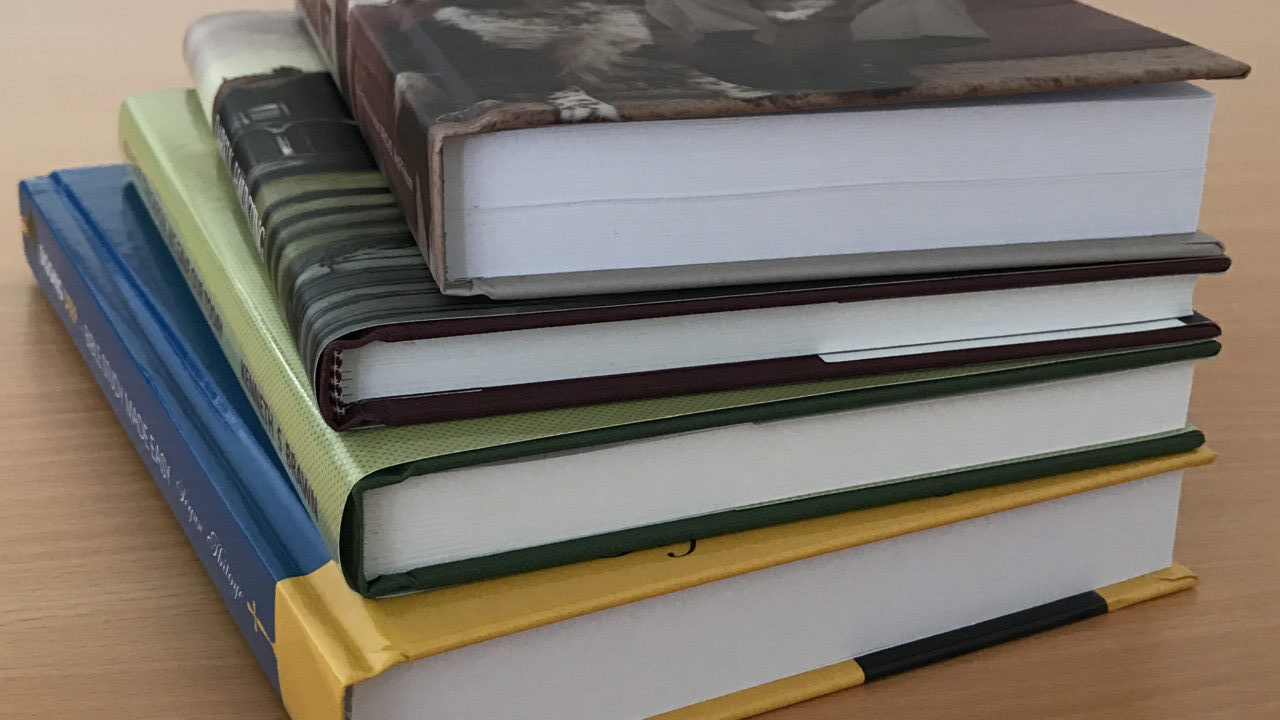A Comprehensive Overview to the Refine of Hardbound Books Printing
When you commence the journey of hardbound book printing, comprehending the entire procedure is necessary. As you navigate via binding and high quality control, you'll discover that every decision affects the book's overall appeal.
Understanding the Hardbound Publication Framework
When you check out the world of hardbound publications, you'll rapidly notice that their framework is distinct and intentional. You'll find a material or natural leather treatment, which not only improves aesthetic appeals however likewise adds to the publication's long life.
The text block itself includes numerous signatures, or folded sheets, sewn together for stamina. You'll see that the spinal column is strengthened, permitting a smooth lay-flat analysis experience - hardcover books. Furthermore, the book's weight often conveys a feeling of quality and durability
Hardbound publications commonly include a dirt coat, which acts as a marketing tool while protecting the cover. Understanding these components helps you appreciate the workmanship behind hardbound books and their special charm in the literary globe.
Manuscript Preparation and Modifying
Getting your manuscript prepared for printing is necessary, and it begins with correct formatting guidelines. You'll need to understand the editing process to improve your job and guarantee it reverberates with viewers. And also, mastering proofreading techniques can aid you catch those bothersome errors prior to your book goes to print.

Manuscript Format Guidelines
Correct manuscript format is vital for producing a professional-looking hardbound publication. Beginning by picking a standard typeface like Times New Roman or Arial in 12-point dimension. Use double-spacing throughout the paper to enhance readability. Set your margins to 1 inch on all sides, giving your message area to take a breath. Number your pages in the top right edge, and include your phase titles at the start of each new area. Usage clear headings to indicate areas, and stay clear of extreme format like vibrant or italics unless required. Make certain to check your manuscript for uniformity in style, ensuring that whatever from spelling to spacing sticks to your chosen guidelines. Following these steps will establish a strong foundation for your book.
Editing Process Basics
Editing your manuscript is an essential action that can transform it from a harsh draft into a sleek last product. Keep in mind, editing and enhancing isn't simply about taking care of errors; it's regarding fine-tuning your voice and ensuring your message resonates with readers. Embrace the procedure, and you'll see your manuscript luster.
Proofreading Methods Summary
Once you've brightened your manuscript with modifying, the next action is to ensure it's free of mistakes that can sidetrack viewers. Review your manuscript out loud-- this helps you hear awkward phrasing and area typos. Take into consideration printing your manuscript; reading on paper can disclose mistakes that screens miss.
Creating guide Cover and Interior
When you're creating your publication cover and inside, you'll intend to concentrate on crucial style elements that record your target market's interest. Picking the best typography designs and carefully choosing colors and imagery can make all the distinction in communicating your book's theme. Let's explore just how these selections can boost your job and attract viewers.
Crucial Layout Components
Developing an attractive book cover and a well-designed inside is crucial for drawing in visitors and enhancing their experience. Start with the cover; it's your impression. Pick colors and photos that show your book's theme and state of mind. Make certain your title sticks out and is clear, even in thumbnail dimension.
A clean, well organized design aids visitors navigate effortlessly. Keep in mind, a cohesive design throughout your publication fosters a professional appearance that can significantly impact a visitor's decision to choose it up.
Selecting Typography Styles
Typography plays a necessary function in both the publication cover and interior decoration, shaping how viewers perceive your material. When choosing typography designs, consider your publication's genre and target audience. A traditional serif font might work well for literary fiction, while a modern sans-serif may suit a contemporary novel. Guarantee readability; your message ought to be very easy on the eyes, specifically for longer passages. Focus on font size and line spacing, as these aspects influence general circulation. Blending typefaces can add interest, but limit it to two or 3 to preserve coherence. Finally, assume concerning power structure-- utilize different styles for headings and body message to direct visitors effortlessly through your job. Your typography options will significantly impact the visitor's experience.
Shade and Imagery Choice
Choosing the ideal colors and images is vital for catching viewers' attention and conveying your book's motifs. Beginning by considering your style; vibrant colors could help a children's book, while low-key tones fit a mystery novel. hardcover books. Usage imagery that resonates with your material-- photos, images, or abstract designs can boost your message
Think about the feelings you intend to stimulate. Cozy colors can develop excitement, while amazing shades frequently communicate calmness. When making the cover, make sure the images does not bewilder the title and author's name; clearness is essential. Inside, use constant color pattern that enhance your typography. This cohesive approach not just raises your book's visual but also improves the visitor's experience, making it much more unforgettable.
Choosing the Right Paper and Products
When selecting paper and materials for your hardcover book, it's important to contemplate how they'll influence the general look of your task. Begin by selecting the appropriate paper weight; much heavier stock often communicates high quality and sturdiness, while lighter paper can produce a much more fragile touch. Take into consideration the finish as well; shiny paper improves shades and images, while matte can supply an innovative, downplayed look.
Don't ignore the cover materials. Fabric, leather, or published paper can establish the tone for your publication. If your project includes pictures, choose acid-free paper to avoid yellowing gradually. Additionally, consider the binding materials; using top quality adhesive assurances your book lasts.
Ultimately, the choices you make below show your vision, so make the effort to example different products (hardcover books). Your options will certainly aid produce my site a book that's not only visually enticing yet useful and also long lasting
The Printing Refine: Strategies and Technologies
A range of printing strategies and innovations can bring your hardcover publication to life, each offering one-of-a-kind advantages. Digital printing is a preferred option for short runs, enabling for fast turnaround and affordable solutions.
For special impacts, you may consider methods like foil stamping or embossing, which can include an extravagant touch to your cover. In addition, you can go with different inks, consisting of green alternatives that deal with ecologically mindful readers. Comprehending these strategies aids you make notified choices, guaranteeing your hardcover book not just looks great however likewise fulfills your production requires successfully. Choose the best approach to raise your publication's appeal and effect.
Binding Techniques for Hardcover Books
Numerous binding methods can change your hardcover publication right into a long lasting and eye-catching product. One popular alternative holds true binding technique, where the pages are sewn with each other and after that connected to a tight cover. This supplies superb sturdiness and a professional look. Another technique is the ideal binding, which makes use of adhesive to hold the pages with each other, enabling for a sleek spinal column yet less toughness contrasted to situation binding.
You could also consider spiral binding, which permits your publication to lay level, making it optimal for guidebooks or workbooks. Nonetheless, it does not offer the same safety cover as instance binding. There's the saddle stitch method, suitable for smaller sized publications, where sheets are folded and stapled with each other. Each binding approach has its advantages and fits various requirements, so assume concerning your publication's objective and target market when choosing the most effective option for your job.
Quality Assurance and Final Touches
After selecting the right binding technique for your hardcover publication, quality assurance becomes vital to confirm your end product satisfies your assumptions. Beginning by checking the printed pages for any kind of mistakes or incongruities in color and design. You do not want to miss any kind of typos or misprints that might impact your readers' experience.
Next, examine the binding honesty. Verify the pages are safely affixed which the spinal column is durable. A well-bound book not only looks expert yet also feels durable in your hands.
Additionally, take notice of the cover. Seek any scuff marks or misalignments in the art work. If you've opted for unique coatings like embossing or aluminum foil stamping, make certain they're used consistently across all duplicates.
Finally, carry out an extensive inspection of the whole set before relocating to distribution. By doing this, you can validate that every publication mirrors your high standards.
Often Asked Questions
For how long Does the Hardbound Book Printing Refine Commonly Take?

What Is the Minimum Order Amount for Hardcover Books?
The minimum order amount for hardbound books normally begin around 100 copies, but it can differ based upon the printer. You must contact your selected printing service for their certain demands and rates.

Can I Print Hardbound Books in Customized Sizes?
Yes, you can print hardcover books in custom dimensions. Lots of printing services offer adaptability with measurements, go to this site allowing you to select a layout that fits your project. Simply validate the specifications before placing your order.
Exist Eco-Friendly Options for Hardcover Publication Printing?
Yes, you can locate green alternatives for hardcover publication printing. Many firms utilize recycled materials and sustainable inks. Just ask your printer concerning their eco-friendly techniques to ensure your job lines up with your ecological worths.
What Are the Prices Related To Hardcover Book Printing?
When considering hardcover book printing expenses, you'll need to element in products, design, and printing methods. Added expenditures like delivery and binding can likewise impact your general budget plan, so plan appropriately for your job.
When you commence the journey of hardbound publication printing, understanding the entire process is important.A range of printing strategies and modern technologies can bring your hardcover publication to life, each offering distinct benefits. Exactly how Long Does the Hardbound Publication Printing Process Commonly Take?
The hardbound publication printing process normally takes about 2 to 6 weeks.Yes, you can discover environmentally friendly choices for hardbound publication printing.